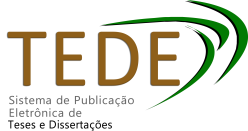| Compartilhamento |


|
Use este identificador para citar ou linkar para este item:
http://tede.unicentro.br:8080/jspui/handle/jspui/1271| Tipo do documento: | Dissertação |
| Título: | BIOLOGIA E ECOLOGIA DE VESPAS E ABELHAS SOLITÁRIAS (INSECTA, HYMENOPTERA) EM FRAGMENTOS DE FLORESTA OMBRÓFILA MISTA |
| Autor: | Brozoski, Franciele  |
| Primeiro orientador: | Buschini, Maria Luisa Tunes |
| Primeiro coorientador: | Lima, Vanderlei Aparecido de |
| Resumo: | Frente aos atuais cenários mundiais acerca da perda de biodiversidade, as atividades humanas tem sido responsáveis pela maior parte das mudanças ambientais que comprometem a persistência das espécies, alteram suas distribuições e ocasionam mudanças nas interações antagônicas e mutualísticas. Inimigos naturais são componentes importantes em comunidades de vespas e abelhas solitárias que nidificam em cavidades preexistentes, pois atuam como um fator de mortalidade relevante e podem regular o crescimento da população hospedeira. No entanto, a interação natural do hospedeiro permanece pouco investigada. Neste estudo nós investigamos se a assembleia de vespas e abelhas que nidificam em cavidades preexistentes e inimigos naturais associados difere em dois fragmentos de Mata Atlântica e em duas áreas abertas. Para a amostragem destes insetos, ninhos-armadilha confeccionados de madeira e de bambu foram instalados em dois fragmentos de floresta e em suas áreas abertas. Um total de 580 ninhos-armadilha foi coletado nas áreas estudadas. Sete espécies de vespas foram comuns às áreas de floresta e abertas, e a maior abundância de ninhos foi encontrada na área aberta (350 ninhos), onde ocorreram 22 espécies de vespas e sete de abelhas. O estimador de riqueza Chao1 indicou que a riqueza esperada foi muito próxima da observada para todas as áreas. Apesar de não verificarmos diferenças significativas para os índices de diversidade entre os fragmentos de florestas e áreas abertas, foi possível observar que a composição das espécies muda com a retirada da floresta. Foi observado um maior número de interações ocorrendo na área aberta, onde 11 espécies de vespas e abelhas foram atacadas por 19 espécies de inimigos naturais, enquanto que em fragmento de floresta, sete espécies de vespas e nove de inimigos naturais foram observadas. As redes de interação apresentaram um padrão mais generalista e modular, com baixa conectividade e aninhamento, enquanto que os valores de robustez indicaram que as espécies hospedeiras são mais fortes para resistirem a extinções secundárias, tornando a rede mais estável para as espécies hospedeiras. |
| Abstract: | Before current global scenarios of biodiversity loss, human activities have been responsible for most environmental changes that compromise the persistence of species, alter their distributions, and bring about changes in antagonistic and mutualistic interactions. Natural enemies are important components in communities of solitary wasps and bees that nest in preexisting cavities, since they act as a relevant mortality factor and may help regulating the growth of the host population. However, the natural interaction of the host remains little investigated. In this study we investigated whether the cluster of wasps and bees nesting in preexisting cavities and associated natural enemies differ in two fragments of Atlantic Forest and two adjacent matrices areas. For the sampling of these insects, trap nests made of wood and bamboo were installed in two fragments of forest and in their adjacent matrix areas. A total of 580 trap nests were collected in the studied areas. Seven species of wasps were common to forest and matrix areas, and the highest nests abundance was found in the matrix (350 nests), where there were 22 species of wasps and seven species of bees. The richness estimator Chao1 indicated that the expected richness was very close to the one observed for all areas. Although we did not verify significant differences for the diversity indexes between forest fragments and adjacent matrices, it was possible to observe that the composition of the species changes with the forest withdrawal. It was observed a greater number of interactions occurring in the adjacent matrix area, where 11 species of wasps and bees were attacked by 19 species of natural enemies, whereas in forest fragment, seven species of wasps and nine species of natural enemies were observed. Interaction networks presented a more general and modular pattern with low connectivity and nesting, while robustness values indicated that host species are stronger to resist secondary extinctions, making the network more stable for host species. |
| Palavras-chave: | Ninhos-armadilha Diversidade Alfa e Beta Redes antagônicas Biologia de nidificação Mata Atlântica Trap-Nests Alpha and Beta diversity Antagonistic networks Nesting biology Atlantic Forest |
| Área(s) do CNPq: | CIENCIAS BIOLOGICAS CIENCIAS BIOLOGICAS::BIOLOGIA GERAL CIENCIAS BIOLOGICAS::GENETICA CIENCIAS BIOLOGICAS::BOTANICA CIENCIAS BIOLOGICAS::ZOOLOGIA CIENCIAS BIOLOGICAS::ECOLOGIA CIENCIAS BIOLOGICAS::BIOQUIMICA CIENCIAS BIOLOGICAS::MICROBIOLOGIA |
| Idioma: | por |
| País: | Brasil |
| Instituição: | Universidade Estadual do Centro-Oeste |
| Sigla da instituição: | UNICENTRO |
| Departamento: | Unicentro::Departamento de Biologia Unicentro::Departamento de Ciências Agrárias e Ambientais |
| Programa: | Programa de Pós-Graduação em Biologia Evolutiva (Mestrado) |
| Citação: | Brozoski, Franciele. BIOLOGIA E ECOLOGIA DE VESPAS E ABELHAS SOLITÁRIAS (INSECTA, HYMENOPTERA) EM FRAGMENTOS DE FLORESTA OMBRÓFILA MISTA. 2019. 111 f. Dissertação (Programa de Pós-Graduação em Biologia Evolutiva - Mestrado) - Universidade Estadual do Centro-Oeste, Guarapuava - PR. |
| Tipo de acesso: | Acesso Aberto |
| URI: | http://tede.unicentro.br:8080/jspui/handle/jspui/1271 |
| Data de defesa: | 25-Mar-2019 |
| Aparece nas coleções: | Programa de Pós-Graduação em Biologia Evolutiva |
Arquivos associados a este item:
| Arquivo | Descrição | Tamanho | Formato | |
|---|---|---|---|---|
| Dissertação - Franciele Brozoski.pdf | Dissertação - Franciele Brozoski | 2,77 MB | Adobe PDF |  Baixar/Abrir Pré-Visualizar |
Os itens no repositório estão protegidos por copyright, com todos os direitos reservados, salvo quando é indicado o contrário.




